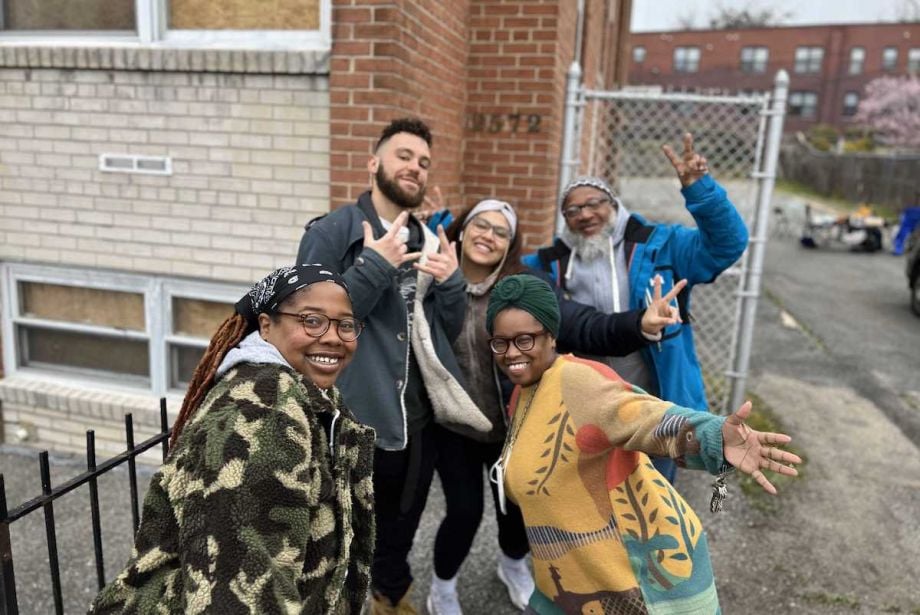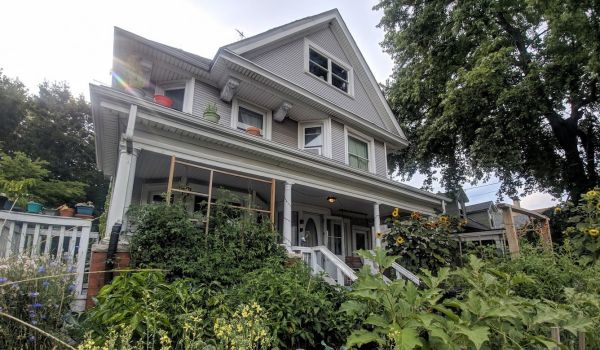Since the district’s landmark Tenant Opportunity to Purchase Act was enacted in 1980, very few tenant organizations in Washington, D.C., have ever successfully purchased their buildings when they’ve gone up for sale.
Though D.C.’s TOPA — the first such policy in the nation — gives tenant organizations the right to make the first offer, as we covered in our December story, housing activists and researchers say that exorbitant real estate costs, a lack of city investment and the difficulty of getting tenants to reach a consensus have all stunted TOPA’s revolutionary potential.
One project in D.C. is poised to defy these odds, thanks to robust tenant organizing and a critical mass of mostly small-dollar donations. But a hefty loan to repay, along with mounting interest, could cut their ambitions short.
Organizers are excited about Northwest D.C.’s Baldwin House, planned as both an affordable housing cooperative and a mutual aid hub. The tenant association reached a compromise allowing some residents to stay, assigning their TOPA rights to a group that will convert their building into a limited equity cooperative intended to remain permanently affordable. As part of the agreement, other tenants will take buyouts from the newly formed nonprofit and move out. The remaining tenants — one long-time resident and another who moved into the building last summer — will live in the building as “tenant stewards,” along with new tenants after an application is made public.
Zuleima Santos, a 24-year-old recent college graduate, heard about the Baldwin House Community Collective while organizing tenants in her family’s apartment on Park Road. She’s now helping to plan the cooperative and hopes to move into the building next year, though the apartments will have a public application process for its tenant stewards.
“Hopefully next year I will have a home I can afford,” Santos said. “We like to call ourselves tenant stewards instead of tenant owners because we feel like we’re stewards of the earth and the world.”
Abi Shakur, 27, was born in D.C. and is one of two current residents of Baldwin House. Shakur said their family was priced out of D.C. when they were only 10; they eventually moved back for college. They said they were asked to leave their previous residence and were precariously housed for a few months before moving into the building.
“I’ve been housing insecure my entire adult life up until September when I was able to move into Baldwin house. And this is the most stable I’ve ever been,” Shakur said.
The new cooperative is intended in part to “put a stopgap in the constant cycle of gentrification that this neighborhood has just been experiencing for decades,” says Natacia Knapper, a current resident of Baldwin House who will stay in the building when it converts to shared ownership.
The purchase was made through the gifts of 500 donors totaling more than $600,000, as well as a $2.2 million loan from Local Initiatives Support Corporation. The money was raised through a combination of online crowdfunding and the mobilization of wealthy donors through the group Resource Generation.
Right now, the building has six units, but it will undergo renovations sometime in 2024 to transform it into an 8-unit building, according to Knapper. The building’s commercial space will be transformed into two new residential units as well as a mutual aid space rented by Ward 1 Mutual Aid and space for community projects. The building also has a community garden, already underway, built by a member of the Baldwin House Community Collective.
Knapper has been living in the building for 10 years, having moved to the neighborhood after being priced out of nearby Logan Circle. Tenants have been dealing with ongoing maintenance problems in recent years, Knapper says: One winter, the heat didn’t work for two months. At various points, the lock on the front door was broken. There was damage to the roof. As residents pushed the landlord for repairs, the owner decided to sell the building instead.
Knapper was a member of Ward 1 Mutual Aid, a collective formed during the pandemic to assist food-insecure neighbors. The organization hosted a reading group about cooperative living that Knapper participated in.
When Knapper learned that their landlord planned to sell the building, they brought the news to the reading group. Until then, the group had been engaged in abstract discussion but had no concrete plans for action.
“We thought, OK, this is an opportunity to take all the learnings that we’ve had around cooperatives and actually try to apply it to purchasing this building and turning it into a cooperative,” Knapper says.
They assembled a group called The Baldwin House Community Collective — named after the writer and civil rights icon James Baldwin — to help Knapper and other willing tenants buy the building and transfer it to community ownership. The collective secured a fiscal sponsor in the North American Student Cooperative Organization, which allows it to function legally as a nonprofit and to secure grants.
But when they started speaking to tenants, they realized not all of them actually wanted to cooperatively own the building — a long process.
Knapper says many residents, aware that the building was deteriorating, did not want to wait for it to be fixed under a cooperative structure with an uncertain timeline. “Folks just really want to live in a safe, clean, living space where they can have that environment right away, which I think is completely fair,” Knapper says.
So tenants and the Baldwin House Community Collective — whose members were not tenants of the building, except for Knapper — reached a compromise. The collective would raise money for “buyouts”: lump sum payments of $40,000 to each family of tenants who wished to leave, in exchange for assigning their TOPA rights to the Baldwin House Community Collective. The group would also fundraise for a counter offer on the apartment building. They say that the original offer to the landlord would have kicked out residents with two weeks’ notice on the holidays.
Coming to that agreement wasn’t easy. “There was a lot of work that needed to be done around building trust with people,” according to Knapper.
The group began fundraising for these payments quickly, raising $200,000 in six months for the five families who decided to leave.
But even with a groundswell of fundraising, the group had to take on debt to purchase the building, making its future precarious. Current residents are paying 30% of their income toward rent, Shakur says, a model the co-op wants to continue as more residents move in.
The group raised $1.4 million in zero-interest loans, Shakur says, as well as a $2.2 million loan from Local Initiatives Support Corporation (LISC) to acquire the building and perform maintenance and upgrades. But the latter loan has put them in a challenging position: According to the group’s online fundraising page for its “Debt-Free Futures” campaign, they will owe $8,000 a month in interest on top of their loan payments. For this reason, they’re hoping to raise more than $2 million to pay back the LISC loan, with a goal of eliminating the debt by Juneteenth 2024.
Abi Shakur, a member of the Baldwin House Community Collective and the other current resident, says the first loan payment on this loan is not due until June 2026. But $8,000 in monthly interest is still being added to their loan’s principal, causing the total loan amount to balloon.
Shakur said the group was limited in what types of loans they could take out; they were rejected for traditional bank loans because they’re a limited equity cooperative. This makes refinancing to a more traditional 30-year mortgage with a lower, fixed-interest rate challenging.
“It’s been really frustrating,” Shakur says. “I think what we’re running into is systemic issues of the banks [not wanting to] give mortgages to coops, especially limited equity coops.”
Shakur says the group’s initial plan was to secure interest-free down payment assistance from D.C.’s Home Purchase Assistance Program, but the program ran out of money earlier than expected.
If the loan isn’t paid back, Baldwin House will not be able to offer affordable rents as intended Shakur says the group now plans to fundraise the loan payments, both from small donors and through Resource Generation, a nonprofit mobilizing young people with inheritances and generational wealth to put their financial resources toward social justice causes.
The limitations of TOPA
The Baldwin House project highlights one of the biggest challenges of allowing tenants to purchase a building through D.C.’s TOPA law. In a TOPA process, tenants have to vote on an outcome, even if it’s a compromise where some people leave and some people stay or one where purchase rights are sold to a developer or assigned to a nonprofit. The challenge of reaching this consensus is one of the reasons that having tenant organizers and attorneys on hand is a necessity.
A report on TOPA released last August by a housing coalition within the Democratic Socialists of America’s D.C. chapter relayed the difficulty of getting tenants to agree with one another. The housing subgroup, “Stomp Out Slumlords,” says that in 2021, after organizing rent strikes with tenants at the beginning of the pandemic, five properties the group organized within were sold in two months.
All the sales triggered a TOPA process, and the DSA organized with those tenants to help them navigate the process, but the choice before them led to clashes of interests.
“People were suddenly faced with a stark choice between staying put and leaving with a fistful of cash,” according to the DSA report. “Compromise proves difficult: ultimately only one entity can buy a building, and there are unavoidable tradeoffs between catering to tenants who want improved conditions and affordable rent and tenants who just want to leave with as much money as possible.”
The result, the report says, was that “leaders began to turn on one another, factions formed, meetings devolved into shouting matches, anti-committees formed and started agitating against our program for the first time, and tenant association WhatsApp groups became even more toxic than the DSA discussion forums.”
The DSA group, which had been organizing with tenants against their landlords, found that the unified front had collapsed once TOPA rights kicked in. Ultimately, the group says, they doubled down on organizing, including one-on-one meetings with tenants, and were able to negotiate for improvements in all five buildings that went through TOPA. One of the buildings became a cooperative, tenant associations at three buildings assigned their TOPA rights to nonprofits who purchased the buildings, and another building’s tenant association negotiated rent restrictions with an incoming for-profit developer.
Some tenants at Buena Vista, the building that became a co-op, however, are still fighting to be bought out. Judy Meima, a consultant hired by Buena Vista’s co-op board to secure financing, said, “The overwhelming majority of the 33 households however, continue to support the coop.”
Public financing to repair the building and keep it affordable dried up as federal interest rates and mortgage rates rose, but the co-operative has still managed to secure $200,000 in funding for repairs, according to Meima. This includes a $100,000 settlement against the prior landlord to make repairs and another $100,000 repair loan from LISC. The co-operative is also funding some repairs through its rent rolls. But many other tenants across properties have rejected buyouts based on the experiences of friends and relatives.
“They knew enough people who had accepted buyouts in the past, expecting to buy a home, who had ended up in an equally lousy apartment in a far-flung suburb spending even more on rent and transportation and isolated from jobs, families, and community institutions,” according to DSA.
The report also points out that tenants trying to purchase their buildings under TOPA have to compete with speculators — who are estimating the value of the building based on how much they can make under new tenants.
“Current prices are based on assumptions that rents will rise substantially. The market is pricing in displacement,” the report says.
A new model for renters
The Baldwin House Cooperative has not yet finalized the details of its project, but Knapper says that the hope is to create a living arrangement that will not resemble the traditional landlord/tenant relationship.
For this reason, all the tenants of the new Baldwin House Cooperative will be referred to as “stewards.” Tenants will still have to contribute rent for maintenance, property taxes and operational costs, but the building will be kept off the speculative market.
Knapper said that the collective will prioritize long-time residents of the neighborhood as tenant-stewards and that decisions on how the “mutual aid” aspect of the project will work will be finalized after further community conversations. So far, the group has had conversations about providing free bathrooms with full showers for unhoused people, an art studio and plans to rent a meeting space for Ward 1 Mutual Aid organizers.
Baldwin House organizers say that tenant stewards are currently working on projects involving urban farming, supporting incarcerated artists, as well as storytelling D.C. co-op history.
But figuring out the community function of the space, much like the process of coming to a consensus with Baldwin House tenants, will take a lot of organizing.
“What are the things that would make the community feel like they are part of building this thing?” Knapper asks. “How can we have this be a space where the community knows that this is theirs, too?”
Shakur says that despite the challenges ahead, they are dedicated to making Baldwin House work.
“I really could not overstate how much Baldwin house means to me,” they say. Shakur says they’re indebted to the work of community organizers and mutual aid and want to carry those ideals forward in the space.
“It’s profoundly exciting to have land and a place to build on those virtues in a really substantive way,” they say. “I can only imagine what an impact that would have made on me in my childhood growing up in a poor city with a lot of other poor people who are suffering and struggling to survive.”
This story was co-published in collaboration with Shelterforce, the only independent, non-academic publication covering the worlds of affordable housing, community development and housing justice. We’ve corrected this story to reflect that tenants at Buena Vista have been able to fund and make some repairs, and we’ve added commentary about the state of residents’ support for the co-op.
This article is part of Backyard, a newsletter exploring scalable solutions to make housing fairer, more affordable and more environmentally sustainable. Subscribe to our weekly Backyard newsletter.

Roshan Abraham is Next City's housing correspondent and a former Equitable Cities fellow. He is based in Queens. Follow him on Twitter at @roshantone.


















